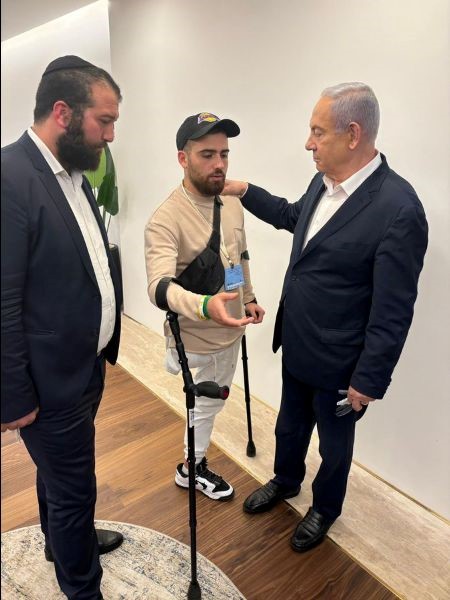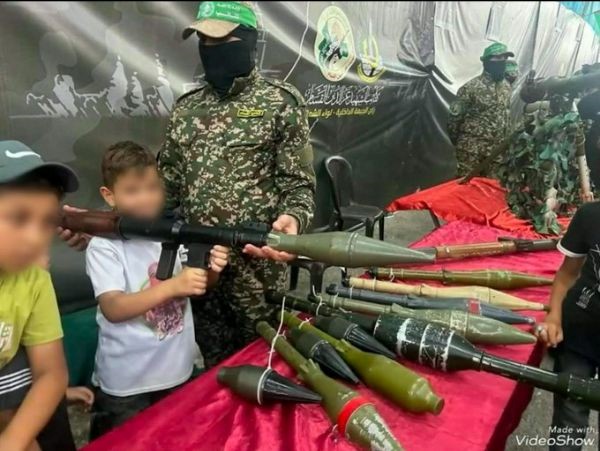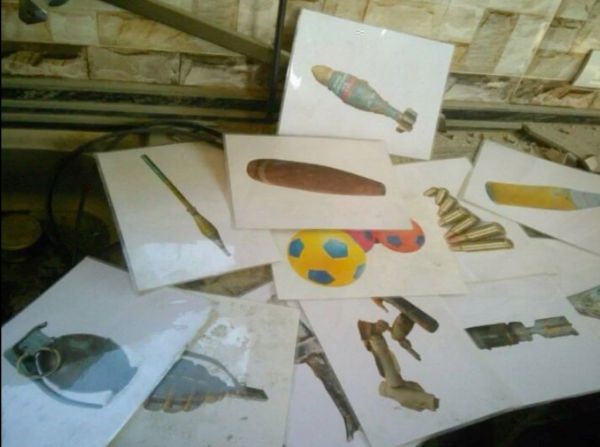Foreign Secretary Lord Cameron said that the UK and U.S. are “clear” in condemning “the illegal attacks by the Houthis in the Red Sea and will hold them accountable”. He made the comments on his X account, formally Twitter, relating to a call with Israel’s Foreign Minister Israel Katz.
Katz, who took on the position of Israel’s Foreign Minister on Tuesday, said on X that he expressed Israel’s “deep appreciation for Britain’s unwavering support for Israel after the Hamas October 7th terrorist attack” and that the two discussed their “commitment to realise the release of all the hostages, including the British ones”.
He added that the two spoke about “the need to increase international pressure against Iran, which destabilises the region through its proxies Hamas, Hezbollah, the Houthis and more”, whilst raising the importance of “opposing South Africa’s absurd appeal” to the International Court of Justice.
Pictures of weapons used in schools evidence Hamas indoctrination
Israel released images of children in Gaza given weapons by Hamas terrorists, stating that they are being sent into combat zones by Hamas to transfer weapons, travel through terror tunnels, assess and report back from battlefields, and that they train alongside Hamas members.
Israel’s Coordination of Government Activities in the Territories (COGAT) released images of learning materials found at a school in Gaza, featuring images of weapons such as grenades and bombs, reportedly pointing to evidence of Hamas’ indoctrination of Palestinian children.
Hamas deputy killed in strike in Beirut
Saleh al-Arouri, the deputy of Hamas’ politburo who was reportedly responsible for coordinating Hamas terror activity in the West Bank, was killed in a UAV (unmanned aerial vehicle) strike in Beirut on Tuesday evening.
A third-floor Hamas office in the Beirut neighbourhood and Hezbollah stronghold of Dahiyeh was targeted in what Lebanese news agencies have called an Israeli drone blast. Israel has declined to comment.
Arouri was recorded prostrating “in gratitude” whilst watching the Hamas-led 7th October massacre as the terror group’s atrocities were filmed and widely distributed by the perpetrators. He has openly praised the massacres of some 1200, mostly civilians, as a “liberation” and is believed to have planned the 2014 kidnapping and murder of three Israeli teenagers; Gilad Shaar, Eyal Yifrach and Naftali Fraenkel, according to reports.
Arouri was released together with Hamas’ leader in the Gaza Strip, Yahya Sinwar, and around 1000 others in return for the Israeli hostage Gilad Shalit in 2011, who was freed from the terror group and returned to Israel.
After moving from Turkey to Syria and then Lebanon, Arouri reportedly created a Hamas cell with those in Palestinian refugee camps in Lebanon.
Six others were killed in the strike, including terror commander Samir Findi who allegedly oversaw Hamas decisions in Lebanon including rocket fire into Israel, and who coordinated with the Iran-backed, Yemen based, Houthi terror group.
Hassan Nasrallah, the leader of Lebanon’s Iran-backed Hezbollah terror group which has launched almost daily rocket strikes against Israel since the Hamas-led 7th October attacks, was considered close to Arouri. He has reportedly vowed to retaliate to Israeli operations targeting Hamas members in Lebanon.
In late November 2023, Israel’s Prime Minister Benjamin Netanyahu, said that he had instructed Mossad to target Hamas leaders “wherever they are”.
Houthi terror group meets with Iran’s officials to discuss future coordination
The Iran-backed Houthi terror group, which has recently disrupted major international trade by launching attacks on commercial vessels in the Red Sea, sent representatives to meet with Iranian officials to plan their shared near-term strategy, according to reports.
Mohammad Abdul Salam, the leading Houthi negotiator, met with Iran’s Foreign Minister Hossein Amir Abdollahian and other key officials, according to Yemeni media reports.
Salam and Abdollahian reportedly discussed UN negotiations, the Israel-Hamas War, and “strengthening the steadfastness of the valiant Palestinian resistance”. Salam also met with the Secretary of the Iranian Supreme National Security Council, Ali Akbar Ahmadian.
This week, the Houthi terror group orchestrated attacks on ships in the Red Sea via missiles and small boats. An Iranian destroyer warship has also reportedly been deployed to the area.
In Iraq, where pro-Iranian terror groups have been attacking U.S. military bases and which shares strong ties to Tehran on a governmental level, a bilateral coalition is being formed to prepare for the end of the U.S.-led international coalition in the country. The announcement was made today by the countries Prime Minister Mohmmed Shia Al-Sudani.
Hezbollah tunnels far more sophisticated and widespread than Hamas’
Hezbollah’s tunnel system is far more extensive and sophisticated than Hamas’, according to new reports.
The Lebanese terror group, which is backed by Iran, began the construction of its tunnel network long before Hamas’. North Korea, as far back as the 1980s, has reportedly assisted proactively in their establishment. After the second Lebanon War of 2006, Iran stepped up efforts to aid in the development of the tunnel systems.
Tens of thousands of residents of Israel’s northern neighbourhoods have been recently evacuated, in measures responding to continuous Hezbollah rocket fire and the possibility of a 7th October style escalation. This has prompted renewed attention in the vast terror capabilities and infrastructure exhibited by Hezbollah.
A hugely complicated web of subterranean tunnels, mapped with markings of 36 polygons indicating “regions, towns and villages” was investigated by the Alma Research and Education Center using open-source intelligence, according to a recent interview with Tal Beeri, Director of the organisation. Each polygon signifies a stronghold equipped with its own underground network, according to Beeri.
The tunnels surmount to a subterranean maze hundreds of kilometres long. A single 45-kilometre tunnel was mapped in a 2021 report by the Alma Research and Education Center, which has “collected information from a series of sources and videos” for almost a decade.
Beeri identified three types of highly developed tunnel constructed by Hezbollah: “Attack tunnels, particularly large and long tunnels that lead from area to area. One can enter them in vehicles and even medium-sized trucks”.
Tactical tunnels, intended for “people only to move around in, and in extreme circumstances, maybe a motorcycle”. Close to villages, they enable terrorists to “fight from underground — to fire from tunnel shafts and duck back in, to rearm from weapons stores inside, to rest, and emerge again”.
The third tunnel type, “proximate tunnels”, allow for “access almost to the border”, from where militants can “emerge and attack”. Beeri said that the Radwan Force – Hezbollah’s elite unit – intends to seize the Galilee utilising these types of tunnels.
Multiple companies, including Jihad Construction, Mustafa Commercial and Contracting Company have reportedly worked to develop the tunnels system under the guise of civil construction contractors.
Israel carried out strikes on Hezbollah outposts in southern Lebanon’s Ayta-ash Shab and Majdal Zoun today.

Suspects arrested as fighting continues across the West Bank
18 have been detained and six arrested in operations in the Nur Shams refugee camp in the West Bank, the IDF reported. An Israeli UAV struck operatives attempting to launch explosives at Israeli forces.
In the West Bank town of Qalqilya, weapons were seized and four suspects were also arrested. Early this week, a terrorist was killed by the IDF in the area. Israeli territory between Qalqilya and the Mediterranean Sea is only around 12 kilometres wide.
In the West Bank town of Azzun, four Palestinian terrorists were killed in a firefight overnight Monday, the IDF said. Three makeshift “Carlo” submachine guns were obtained by the army. Seven other terrorists were detained elsewhere across the territory.
Hamas intelligence centre secured by IDF in northern Gaza
An intelligence centre, considered the most important discovery in northern Gaza, second to the cities main military quarter, has been reportedly secured by the IDF.
The site is thought to direct Hamas’ military activities right across the Gaza Strip, in contrast to other command centres which manage smaller areas of fighting. 37 structures, a vast tunnel network dropping 20 meters underground, three tunnel elevators, extensive stairs, and blast doors were discovered at the site.
It was protected by successive contingents of Hamas terrorists, equipped with unusually large numbers of advanced anti-tank missiles, mortars and other weapons were deployed against the IDF by Hamas.
The battle for the complex heralded a change in tactics for Hamas, which mid-battle organised for terrorists to run across rooftops and take to their underground tunnel networks in a purposeful and coordinated manner.
The tunnel network connected to various civilian-turned-military stations, including a mosque, school, and the Rantisi Children’s Hospital. Hamas held meetings and stored large arms depots at the civilian sites. The IDF arrested a Hamas official responsible for coordinating digging activities there, and recovered the remains of a soldier killed on 7th October.
In Khan Younis, the IDF destroyed rocket launch sites. Separately, troops found a chemical lab used for weapons manufacturing, and a warehouse. In a central Gaza neighbourhood, soldiers discovered tunnel shafts, booby-trapped homes and weapons. The tall tower blocks in the area were used as “anti-tank missile and machine gun positions”, the IDF said. The army struck over 100 Hamas targets generally over the past 24 hours.
A U.S. senior intelligence official has reportedly confirmed that Hamas and Palestinian Islamic Jihad used Gaza’s Shifa Hospital and sites beneath it to direct Hamas terror activities, hold “at least a few hostages” and store weapons.
Late last month, the IDF discovered explosive devices in a children’s playground connected to a nursery on the periphery of the Shati refugee camp and carried out air strikes against cells of Hamas personnel intending to detonate explosives at IDF soldiers.




